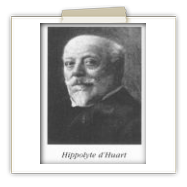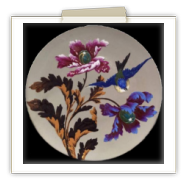(1866 - 1918) The Golden Age of Longwy's Earthenware Factory with d'Huart
The Factory then run since 1866 by the brothers of d'Huart Fernand and Hippolyte will know a transformation and the richness of an abundant period that will give rise to the most fabulous table services, complex and innovative techniques such as Flames, Small Fire, Big Fire, Brocatelle, Majolica, Barbotine, Blue of Sèvres ... But it was around 1872 that began the factory of enamelled pieces. Eugène Collinot is the initiator of this technique around 1860 in his factory in Boulogne-sur-Seine.
At Longwy, the works are decorative and ornamental mainly Eastern in the arrival in 1870 of Charles Longuet, coming from the factory of Sèvres, and the ceramist creator Amédée de Caranza; both will be the initiators of the technical production of enamels in Longwy around 1872. Caranza will join Creil-Montereau around 1876 and the J. Vieillard & Cie factory in Bordeaux in 1878. We will also find similarities in pieces enamels of point of view of the technique peculiar to him. The principle of encircled enamels is to draw with a brush the ring which draws the contours of the decorations with a black enamel with the essence and to put enamel with the drip.
But this artisanal method is expensive in labor and under the impulse of the d'Huart brothers it will very quickly industrialize using the technique of printing to lay out the contours and allow to increase the productivity rate but also in number of forms. In 1873 the decoration workshop counted forty painters to increase to more than two hundred in 1878. The success is dazzling and the Faience factory obtains numerous awards at the universal exhibitions of 1878 and 1889, in Paris, which will mark the apogee of his Art Japan and China are mainly inspired by decorations and forms.
Chinese Art inspired by bronzes brought back to Europe after the looting of the Summer Palace of Beijing in 1860 by England and France and Japanese Art by the prints of Hokusai Katsushita great master prolific in his field whose work was broadcast in Europe from 1861.
The discovery of oriental arts is admired by artists from all over Europe and in particular earthenware factories such as Sarreguemines, Bordeaux, Gien ... and Longwy which will know its eternal fame with the apple blossom. Other artistic inspirations will also be part of the decorations as Islamic art with its Arabic and Persian motifs including the famous ceramics produced in Iznik in the fifteenth and sixteenth centuries. Egypt will also contribute through decorative elements of antiquity such as palms, papyrus, lotus ...
In 1890, the date of the beginning of the "Art Nouveau", the earthenware makes come the painter Carl Schuller whose specialty will be the large ornamental panels in the technique of the circle with the syringe. But in Longwy this art says New will be only a modest contribution to the unique work is majestic Faience while Nancy will become the capital with the glass paste with Daum, Gallé, Muller, ... In 1893 François-Auguste Lindley (known as Franck) is hired by Baron d'Huart to take charge of the artistic workshops. It will keep in certain conservatism of the Oriental productions of the Earthenware but later will be able to take the turning of the Decorative Arts.
By 1900, production is becoming more difficult due to declining business conditions, and the company opts for profitability more than prestige or unique works, and the evolution of the decorations will be simplified, as will the enhancement and the fact that produce mostly enamels with a blue background (the Longwy Blue). In 1901 the company changed its social status to become "Société anonyme des faïenceries de Longwy", with a staff of up to 450 workers in 1914.
After the first world war, the German troops will stop production and the factory will be partly destroyed by bombing.





















